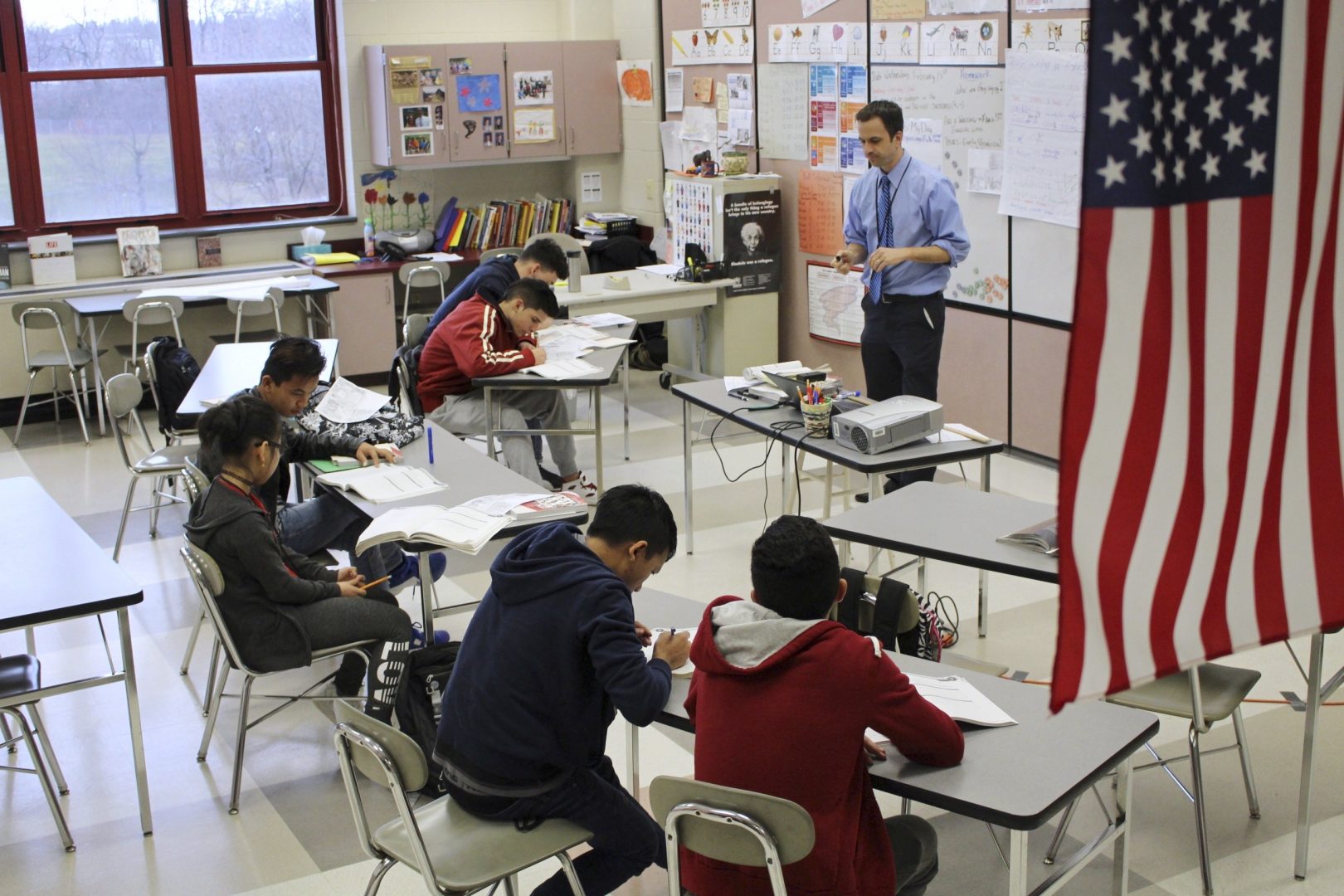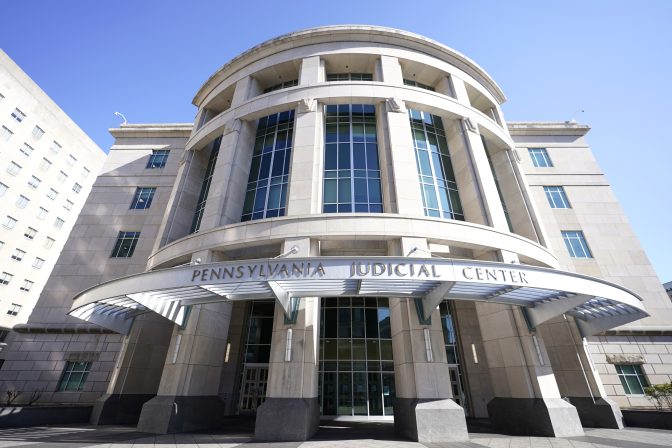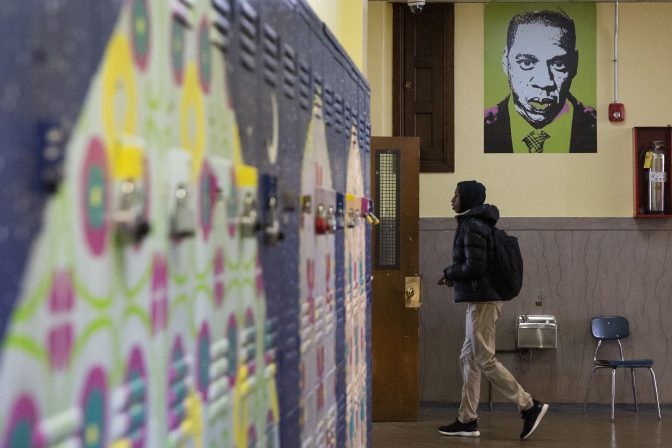
FILE PHOTO: In this Feb. 15, 2017, photo, Eric Hoover teaches his class of immigrant and refugee students at McCaskey High School in Lancaster, Pa.
Michael Rubinkam / The Associated Press

FILE PHOTO: In this Feb. 15, 2017, photo, Eric Hoover teaches his class of immigrant and refugee students at McCaskey High School in Lancaster, Pa.
Michael Rubinkam / The Associated Press

Michael Rubinkam / The Associated Press
FILE PHOTO: In this Feb. 15, 2017, photo, Eric Hoover teaches his class of immigrant and refugee students at McCaskey High School in Lancaster, Pa.
For the final time, parties in a case that could radically change how Pennsylvania funds its public schools faced off in Commonwealth Court.
There is a long history behind this day of post-trial arguments.
Six school districts, six sets of parents, and two advocacy groups first filed the funding lawsuit in 2014. As it has wound its way in and out of court, state leadership has changed over, schools’ financial realities have evolved, and the legal landscape has shifted. Arguments finally began in Commonwealth Court last November.
The biggest question in Tuesday’s post-trial arguments is also at the heart of the entire case: What kind of education does Pennsylvania owe its children?
The petitioners — which include the School District of Lancaster and the Shenandoah Valley School District in Schuylkill County — have been arguing that Pennsylvania’s school system is so underfunded, it violates the state constitution.
“We know what the constitution was aiming for: not sameness or uniformity, but rather equity,” said Katrina Robson, an attorney for the plaintiffs, before running through some of the testimony her team has used to illustrate that point.

Julio Cortez / AP Photo
Shown is a general view of the Pennsylvania Judicial Center, home to the Commonwealth Court in Harrisburg, Pa., on Nov. 6, 2020.
There was Michael Horvath, a 20-year-old Wilkes-Barre School District graduate who testified that he felt unprepared for college and that, as Robson recalled, his dilapidated school “didn’t make you feel good. It made you feel like you were less.”
There were also the statistics. As Dan Urevick-Ackelsberg, another lawyer for the plaintiffs, argued, “When 80% of Black children fail to meet proficiency on state math exams, when 20% of them who graduate will go on to graduate college, when the numbers are similar for low-income children, when the numbers are similar for Latino children … you have to actually examine how the system is actually performing.”
Their actual legal argument is twofold.
First, attorneys for the plaintiffs say Pennsylvania’s public school system doesn’t meet the standard laid out in the constitution’s education clause, which says the legislature “shall provide for the maintenance and support of a thorough and efficient system of public education to serve the needs of the Commonwealth.”
The standard they think the commonwealth should meet, according to their filings, is a “high-quality contemporary education that prepares children for self-sufficiency and civic participation.”
Second, they say funding disparities among school districts violates the state constitution’s version of an equal protections clause.
Underlying the entire case is Pennsylvania’s convoluted method of funding schools.
The commonwealth gets a big percentage of its school funding from local real estate taxes. That means the wealth of a given school district has a lot to do with the amount of money that district is able to raise for public education. More expensive houses mean more tax dollars.

Heather Khalifa / Philadelphia Inquirer
In this file photo, a student walks into a classroom at Jay Cooke Elementary in North Philadelphia. Philadelphia is among the school districts most shortchanged by the way Pennsylvania funds public education, according to a new analysis in a lawsuit challenging the system.
A funding formula determines how state money, which is intended to fill in the gaps between rich and poor districts, is spent.
For a long time, Pennsylvania used a formula based on the idea that a district should never get less than it had gotten the previous year. But it led to massive inequities, with shrinking districts getting more than their share. In 2016, lawmakers passed a new formula that used a per-student equation to distribute money and gave extra weight to districts that serve lower-income kids.
That new scheme, however, only applies to new money, which means the vast majority of state funds that go to schools still goes through the old formula.
The defendants in the suit are the leaders of the commonwealth’s GOP-controlled legislature and Democratic Gov. Tom Wolf — who is in a somewhat awkward position of arguing against mandating funding changes his office has long supported.
They’re arguing that the constitution actually creates a much lower educational standard than the “a high-quality contemporary education” that defendants are looking for.
As Thomas DeCesar, an attorney for Senate President Pro Tempore Jake Corman said, they think that standard should consist of “looking at what curricular opportunities students have, and then looking to see if they are being taught on that curriculum by effective teachers who are appropriately certified and have appropriate experience.”
Asked by Republican Judge Renee Cohn Jubelirer how the defense might measure such a standard, DeCesar said measurement is irrelevant. “Outcomes,” he said, “are widely impacted by out-of-school factors.”
Throughout the trial, the funding reform advocates presented examples of what they believe are unacceptable, inequitable conditions across rural, urban, and suburban Pennsylvania schools.
One teacher at Panther Valley Intermediate School in Carbon County said she bought her own school supplies and had to use a textbook from 1997. Philadelphia’s former superintendent testified that the district’s schools are riddled with asbestos and lead paint it can’t afford to remediate. A kindergarten teacher in the William Penn School District, in suburban Delaware County, says she’s too overworked to give her students individual attention.
Defendants maintain the inequities the plaintiffs point out are cherry-picked and exaggerate the extent of the problems across the commonwealth. Funding increases, they say, have further improved things — as has a new funding formula that is being very slowly implemented.
Patrick Northen, a lawyer for GOP House Leader Bryan Cutler, said by his math, “there’s now about $1.6 billion that passes through this new funding formula. Basic education funding increased for the petitioner school districts and for the school district of Philadelphia, ranging from 8.9% for Lancaster to 26.7% for Wilkes-Barre just from last year.”
The plaintiffs maintain that distribution is still inequitable. If the funding formula were to be fully funded, they note, large poor districts like Philadelphia would get about $400 million more annually.
With these final post-trial arguments finished, Jubelirer will decide whose case is more compelling. Her verdict is expected in the coming months.
After that, the losing party likely will appeal the case to the Democratic-controlled state Supreme Court.

Sometimes, your mornings are just too busy to catch the news beyond a headline or two. Don’t worry. The Morning Agenda has got your back. Each weekday morning, host Tim Lambert will keep you informed, amused, enlightened and up-to-date on what’s happening in central Pennsylvania and the rest of this great commonwealth.
The days of journalism’s one-way street of simply producing stories for the public have long been over. Now, it’s time to find better ways to interact with you and ensure we meet your high standards of what a credible media organization should be.